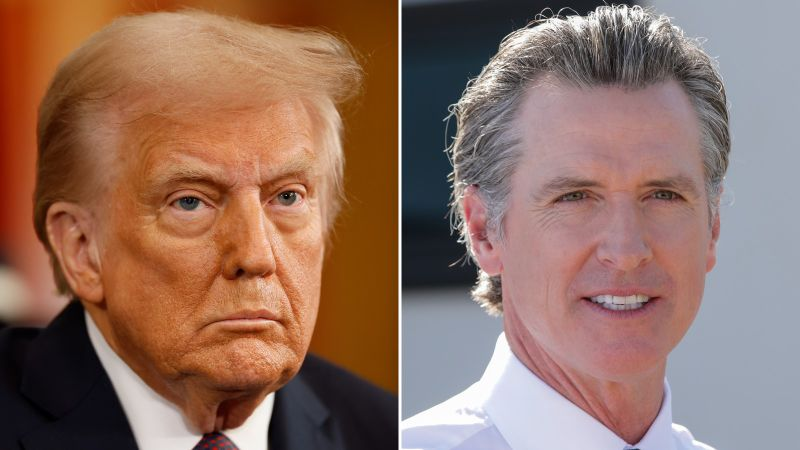CNN —
Advisers to California Gov. Gavin Newsom spent the week monitoring new White House advance staffers’ social media accounts, hoping for clues for where President Donald Trump might be headed when he lands in Los Angeles on Friday afternoon to talk about the wildfire damage.
That’s the state of relations as California and the federal government face one of the most expensive natural disasters ever, and perhaps one of the most complex in American history.
No one is talking between the Democratic governor’s team and the newly inaugurated president’s, two people on the governor’s team told CNN. This is how it’s been: when Newsom sent a letter inviting the then-president-elect to visit California two weeks ago, transition officials confirmed it had been received but never followed up.
Basic details aren’t being shared. Forget about setting up negotiations about managing the response, or even just an invitation to be together.
It’s hard to move forward when the conversation always starts with Trump referring to “Newscum.”
But the fires are still burning.
And the timing and the Santa Ana winds have turned the governor into the first test case for how Democrats and others whom Trump perceives as political opponents manage relationships that tend to start with the personal and petty, wend through misinformation, and rarely evolve into more.
“Part of working with Trump and his administration is managing his ego and the political jabs, but ultimately we have work to do and a responsibility to Californians,” Alex Padilla, the state’s senior senator and a Newsom ally, told CNN.
White House aides, who are still getting set up since Monday’s inauguration, did not return requests for comment.
But late Thursday, Padilla and fellow Sen. Adam Schiff — another longtime object of Trump’s ire, whom he again referred to as “scum” in the Oval Office this week — were invited to fly with him on Air Force One to tour the damage, though both declined in order to be in the Senate to vote on his Cabinet nominees.
Friday morning, after being told Schiff declined, Trump said as he was leaving the White House, “I didn’t invite him. Someone did.”
And when the White House released his schedule on Friday morning, Los Angeles Mayor Karen Bass was included in one of the events for a fire briefing, along with several members of Congress, but Newsom was not.
Amid outrage about water management decisions leading up to the fire, Newsom has made himself an impromptu fire commandant, putting in long hours over 12 of the last 15 days in the mobile operations center, to the point that aides have noted that he keeps showing up wearing the same pair of jeans.
He knows Democrats far beyond California are watching how this dynamic with Trump goes – both those, like him, expected to start exploring 2028 presidential runs, and those who are just trying to pick up the pieces of their party now in 2025.
And Newsom knows Trump wants to make an example of him too.
The governor came into office grappling with the then-first-term president’s claims that not raking the forests was to blame for the catastrophic fires to the north in Paradise. And now Newsom’s facing the end of his term — and perhaps his own political future — being defined by Trump and fire response.
Some supporters and critics ask him why he isn’t picking more of a fight with the president. Others tell him to just kiss up more to Trump.
Some have praised how much he’s been carrying out the response in public through interviews with flames behind him. Others are infuriated by how many fire hydrants were without water and other mismanagement in the run-up to the catastrophe, saying he should be addressing that, or least showing more empathy for the losses and doing fewer of those TV interviews – especially with liberal hosts.
“He’s got to push back on the misinformation without doubling down on the conflict. And ultimately, he has to deliver for the people of California – and that’s what he’s going to be measured by,” one Newsom adviser told CNN. “There’s not a playbook for this.”
Watching what’s happening at home and trying to sort through the dynamics in Washington, several California politicians say that this back-and-forth is proving a microcosm for American politics in the second Trump era.
“The reality is every good story needs a villain,” said Democratic Rep. Sydney Kamlager-Dove, who now holds the seat in Congress that Bass did for a decade before heading to City Hall.
“Trump is incredibly adept at understanding that. Gavin Newsom is also really good at understanding that. The next four years, and this year, I think will be a dance of the storytellers and the story creators. Who’s the villain? Who’s the hero? That’s what political theater has turned into at this point, unfortunately.”
The Newsom-Trump dynamic is unique, and not just because the governor’s ex-wife used to be engaged to the president’s son before she was nominated to be his ambassador to Greece, or because the governor was one of Joe Biden’s last defenders and then a big booster of Kamala Harris. California has a particular hold on the national political imagination, especially for Republicans, as either a paragon of liberal values or the great example of a failed state.
People who have spoken to Newsom say he sometimes falls back on over-analyzing how he sees Trump playing a chess game with him now and in the run-up to the next presidential election.
In the early days of the fires, Newsom and his team knew they were on the back foot as questions swirled about the management of the emergency response and years of decisions along the way. As Trump led Republicans into making this a fight about aid, though, they’ve seen an opportunity to try to claim some higher moral and political ground.
The approach is “open hand, not a closed fist,” the Newsom adviser said. “Ultimately, he’s got to work with the administration, so he’s got to chart a path through a very, very difficult terrain. What he’s really got to be seen doing is protecting California and defending people whose homes burned down.”
As Newsom waits to hear from the White House whether he will even be invited to be with Trump – the president said on Wednesday in an interview with Fox News’ Sean Hannity that he hadn’t even thought about that – his staff planned an event in Pasadena for Thursday to sign a $2.5 billion relief package approved by the state legislature. And he plans to spend Friday getting briefed in Los Angeles about the ongoing firefighting and recovery efforts.
After the bill signing, Newsom told reporters that he is hoping to meet Air Force One when it lands, if he can find out when that will be, but said his philosophy on the president and the fires is “no politics, no finger-pointing.” He said he hopes this won’t be Trump’s only trip to see the damage, because he wants the president in for “not just the short run, but the long haul.”
Long before the fires, Newsom had set up a team focused on fighting misinformation. And it’s become part of the portfolio for staff in Newsom’s government office as well as his outside political operations, on both social media and beyond.
According to their own count, 81 false narratives (some intertwined or overlapping) have circulated about the causes and responses to the fires, and since starting their response, they have tracked millions of engagements on X, Instagram and TikTok. The governor’s team has started a dedicated website on what’s fact and what’s not.
Newsom’s aides feel good about the progress they have, but admit that the efforts have sapped attention and resources, especially when the president of the United States and the owner of one of the largest social media platforms are actively pushing against them.
“How do you operate if you think that the governor of California started these fires to cover up pedophile tunnels under LA? All the energy spent just to fight that back is absurd. We’re in a whole new environment where ignoring the bullsh*t doesn’t work anymore,” said another Newsom adviser. “It feels like dealing with two wars: the fires and the deluge of bullsh*t.”
And Trump has continued saying things about the fires that are not true, both with his own social media posts and Tuesday in the Roosevelt Room, including claiming of Beverly Hills, “a lot of them are wiped out,” though the fires never reached that neighborhood. He complained about restrictions on using more than 38 gallons of water per household, arguing, “when you are a rich person, you like to take a shower—38 gallons doesn’t last very long,” though no such restriction exists, and many people who are not rich are dealing with much more drastic consequences of the fires. He called for a “valve,” which he said directs water from the Pacific Northwest to be turned toward Los Angeles instead of toward the ocean, and blamed the fires on that water being diverted, though no such piece of infrastructure exists.
Trump and allies blame protections for fish and diversity hiring for the situation; Newsom and allies point out how he doubled the number of California firefighters and organized the planes (some of which were delayed in arriving years ago by the first Trump administration).
In his interview with Hannity, Trump used another argument to explain why disaster aid should be conditioned.
“I don’t think we should give California anything until they let water flow down into their system,” Trump told Hannity, making an argument he repeated as he left for his trip to North Carolina on Friday morning.
When he landed in Asheville to survey hurricane damage, Trump said his conditions for California would also include the state implementing new voter ID laws — reflecting his longstanding obsession with claims of illegal voting, which he has consistently blamed for his three losses in the blue state.
That isn’t the only condition that Trump and Republican leaders in Congress are threatening to put on more disaster aid. Among others discussed are tying it to requirements to account for how the money is used and making it part of a larger government funding bill that might otherwise struggle to get enough House Republican votes to pass in a chamber where the GOP holds an even slimmer majority than it did in December.
Democrats have nixed such requirements, with House Democratic Leader Hakeem Jeffries on Thursday calling connecting relief aid to a government funding bill “a non-starter.”
Padilla told CNN that he has had productive conversations with Republican colleagues like Florida Sen. Rick Scott and North Carolina Sen. Thom Tillis, who both needed disaster aid for their states in recent months, expect they will need more, and are wary of conditions.
As for the possibility of trying to tie the aid to a budget bill that provides tax breaks for billionaires, Padilla said that is “offensive and insulting not just to me, but to the families that are struggling and hurting right now in Southern California.”
That’s left people like GOP Rep. Ken Calvert, who’s from a district southeast of Los Angeles and sits on the Appropriations Committee, trying to square the difference. Calvert said he’s never even spoken to Newsom in his six years so far as governor, and though he is a big Trump supporter, he hopes the president will see the need to get past any politics.
“President Trump said the federal government is going to be there for the folks in L.A. This is no fault of theirs. This fire happened. Not everybody in L.A. is rich and famous. And it’s going to be a multi-year effort, and it’s going to require bipartisan cooperation, a lot of work on all levels,” Calvert said.
Dealing with California’s rules around permits and other building restrictions is going to be an issue, Calvert said, but so are those who try to put in more conditions than what he said are the basic “common sense” type, like those that were in the aid packages for Hurricane Katrina.
Newsom knows whatever happens, his last two years as governor and maybe his political future will be defined by rebuilding Los Angeles. Calvert said he believes Trump, as a newly charged president who came out of real estate himself, might be just the right partner, if they can figure out a way through.
“I don’t care what we might think about each other,” Calvert said. “We’ve got to care more about the people that we represent and what’s happening on the ground. People need a roof over their head. They need to feed their kids and they need to get on with their lives. And so we need to get on with it.”





